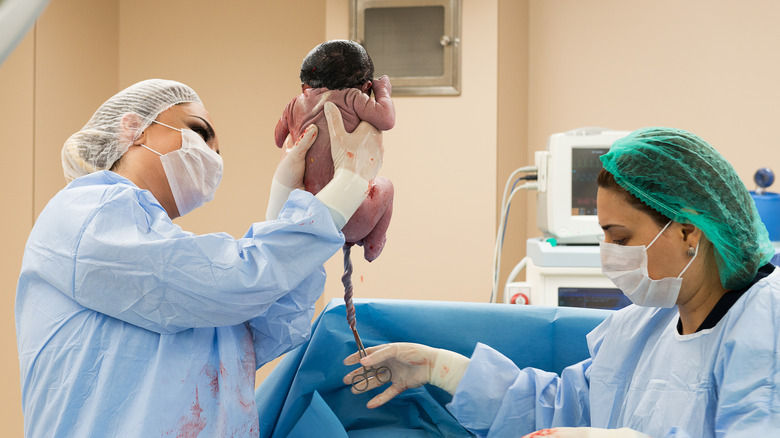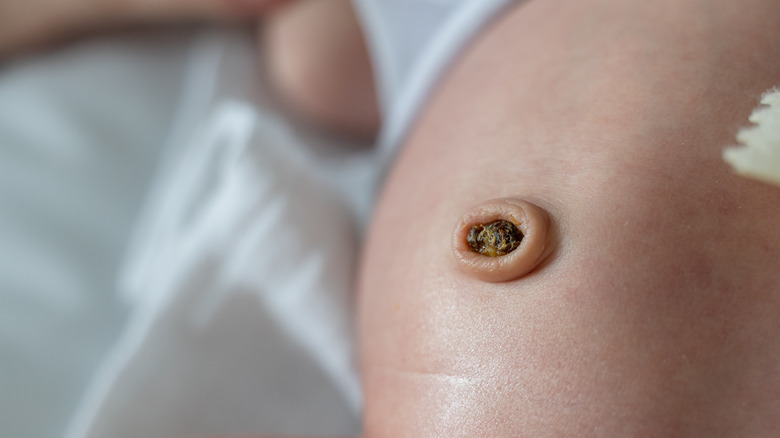The Real Reason Why The Umbilical Cord Shouldn't Be Cut Immediately After Birth
When a baby is born, traditional practice has dictated that the umbilical cord be clamped and cut as soon as possible after birth, according to the University of Missouri Health Care. However, new research and changing practices have shown that there are many benefits to delaying this process. In fact, babies may even grow up to be healthier. The best part? The benefits of delayed cord clamping and cutting apply to all babies, no matter how their birth takes place. This means that babies born prematurely, babies delivered by cesarean section, and babies born through vaginal birthing are all able to reap the benefits.
It was previously believed that delayed clamping and cutting of a baby's umbilical cord would increase the risk of the little one developing jaundice, or yellowing of the skin, as divulged in a 2020 study published in the Journal of Midwifery and Women's Health. In recent years, experts have determined that it doesn't actually carry any risks for the baby's health. Overall, they have been found to be a good thing for babies.
Preterm babies have a greater chance of survival
Premature birth is defined as birth more than three weeks before the due date, and currently, premature births make up nearly 10% of all births (via March of Dimes). Annually, an estimated 380,000 babies are born prematurely in the United States, with preterm birth-related complications comprising the number one reason for infant deaths. The 2020 study found that for babies born prematurely, waiting a full minute after birth to clamp and cut the umbilical cord can decrease the baby's chance of dying in the hospital.
A few extra seconds connected to the umbilical cord, which is in turn attached to the placenta, provides a vital blood source that can decrease the risk of serious health issues for preterm babies (per University of Missouri Health Care). Upon birth, premature babies may experience labored breathing, respiratory distress, low body temperature, and underdeveloped hearts, brains, and gastrointestinal organs, according to Mayo Clinic. As they grow, babies born prematurely are at increased risk of chronic health conditions, cognitive and learning deficiencies, and impaired vision, hearing, and dental development. One condition that preterm babies are at significant risk for is cerebral palsy, which can be caused by inadequate blood flow. Thus, the extra boost of blood from delayed umbilical cord clamping and cutting can save a preterm baby's life.
Babies may be healthier as they grow
For all babies, delayed umbilical cord clamping and cutting can have long-term health benefits (per The Ohio State University). Initially, delaying the detachment of the umbilical cord and the baby's connection with the placenta, the organ responsible for growth while in utero, allows the infant additional time to transition to being outside the mother's womb. Whether born vaginally or through cesarean section, the baby can benefit from the supplemental blood that goes back into their body from the umbilical cord and ultimately increases their blood volume. This increased blood volume at birth decreases the baby's risk for iron deficiency anemia.
Not only are babies able to absorb more blood immediately after birth with delayed cord clamping and cutting, but the process of waiting a minute to clamp and cut the umbilical cord has been linked to increased iron levels by six months of age (via University of Missouri Health Care). The additional blood the baby receives from delayed cord clamping and cutting increases the baby's blood volume, and the process also increases the baby's stores of iron. Having extra iron in the body and blood can decrease the baby's risk of becoming anemic as they grow and can subsequently lead to stronger and healthier development. Since iron isn't transferred very well through breast milk, receiving supplementary blood at birth by delaying umbilical cord clamping and cutting can create healthier babies and children who are able to thrive.



